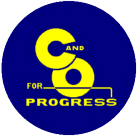
The Chesapeake and Ohio Railway was a Class I railroad formed in 1869 in Virginia from several smaller Virginia railroads begun in the 19th century. Led by industrialist Collis P. Huntington, it reached from Virginia's capital city of Richmond to the Ohio River by 1873, where the railroad town of Huntington, West Virginia, was named for him.

The Louisville and Nashville Railroad, commonly called the L&N, was a Class I railroad that operated freight and passenger services in the southeast United States.

The Union Station of Louisville, Kentucky is a historic railroad station that serves as offices for the Transit Authority of River City (TARC), as it has since mid-April 1980 after receiving a year-long restoration costing approximately $2 million. It was one of at least five union stations in Kentucky, amongst others located in Lexington, Covington, Paducah and Owensboro. It was one of three stations serving Louisville, the others being Central Station and Southern Railway Station. It superseded previous, smaller, railroad depots located in Louisville, most notably one located at Tenth and Maple in 1868–1869, and another L&N station built in 1858. The station was formally opened on September 7, 1891, by the Louisville and Nashville Railroad. There was a claim made at the time that it was the largest railroad station in the Southern United States, covering forty acres. The other major station in Louisville was Central Station, serving the Baltimore and Ohio, the Illinois Central and other railroads.
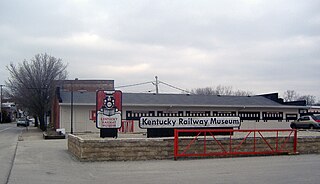
The Kentucky Railway Museum, now located in New Haven, Kentucky, United States, is a non-profit railroad museum dedicated to educating the public regarding the history and heritage of Kentucky's railroads and the people who built them. Originally created in 1954 in Louisville, Kentucky, the museum is at its third location, in extreme southern Nelson County. It is one of the oldest railroad stations in the United States.

The Flim-Flam Man is a 1967 American comedy film directed by Irvin Kershner, featuring George C. Scott, Michael Sarrazin, and Sue Lyon, based on the 1965 novel The Ballad of the Flim-Flam Man by Guy Owen. The movie has well-known character actors in supporting roles, including Jack Albertson, Slim Pickens, Strother Martin, Harry Morgan, and Albert Salmi.

The George Washington was a named passenger train of the Chesapeake and Ohio Railway running between Cincinnati, Ohio and Washington, D.C. that operated from 1932, the 200th anniversary of the birth of George Washington, to 1974. A section divided from the main train at Gordonsville, Virginia and operated through Richmond to Phoebus, Virginia. From the west, a section originated in Louisville and joined at Ashland.

Ashland Transportation Center is an intermodal transit station in Ashland, Kentucky. Jointly operated by the City of Ashland and CSX Transportation, it currently serves Amtrak's Cardinal train as well as the Ashland Bus System, Greyhound Lines, and regional shuttles. It is located at 99 15th Street near downtown Ashland.
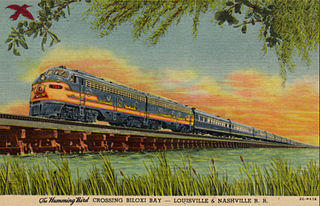
The Humming Bird was a named train of the Louisville and Nashville Railroad (L&N). The train, inaugurated in 1946, originally ran from Cincinnati, Ohio, to New Orleans, Louisiana, via Louisville, Nashville, Birmingham, Montgomery and Mobile and later via a connection at Bowling Green, Kentucky, to Memphis, Tennessee. A connection to Chicago was provided by the Chicago and Eastern Illinois Railroad.

The Union Station in Owensboro, Kentucky, is a historic railroad station, built in 1905. Built mostly for the Louisville and Nashville Railroad, the station is made of limestone and slate, and currently is home to several businesses.
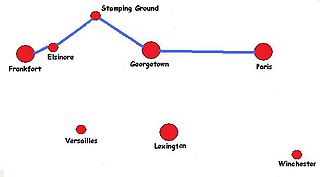
The Frankfort and Cincinnati Railroad is a defunct shortline railroad based in Kentucky. Despite its name, it had no connections with Cincinnati, Ohio.
The Night Express was an American named train of the Baltimore and Ohio Railroad (B&O) on its route between Detroit, Michigan, and Louisville, Kentucky, with major station stops in Toledo, Ohio, and Cincinnati. The service was numbered Train 57 southbound and Train 58 northbound. The numbers 57/58 operated on the Detroit - Cincinnati line as early as 1921. The service was provided in conjunction with the Pere Marquette Railroad from Detroit to Toledo and with the Louisville and Nashville from Cincinnati to Louisville with connections to New Orleans.
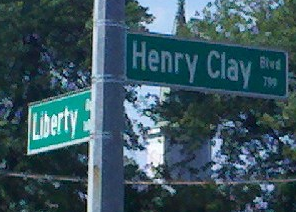
Liberty Heights is a neighborhood in southeastern Lexington, Kentucky, United States. Its boundaries are Winchester Road to the north, New Circle Road to the east, and R. J. Corman railroad tracks to the west and south.
The Fast Flying Virginian (FFV) was a named passenger train of the Chesapeake & Ohio Railway.

The Mountaineer was a passenger train operated by Amtrak between Norfolk, Virginia, and Chicago, Illinois, via Cincinnati, Ohio. It was the first train to use the Norfolk and Western Railway's tracks since the creation of Amtrak in 1971 and followed the route of the Pocahontas, the N&W's last passenger train. Service began in 1975 and ended in 1977. A new train, the Hilltopper, operated over much of the Mountaineer's route but was itself discontinued in 1979.

The Dixie Flyer was a premier named American passenger train that operated from 1892 to 1965 via the "Dixie Route" from Chicago and St. Louis via Evansville, Nashville, and Atlanta to Florida. However, the train continued until 1969 as an Atlanta to Florida operation, run solely by the Atlantic Coast Line Railroad and its successor, the Seaboard Coast Line. The Flyer's route varied in early years, but by about 1920 was set as follows:

Louisville and Nashville Railroad Station, also known as L & N Station, was a historic train station located in downtown Evansville, Indiana. It was built in 1902 for the Louisville and Nashville Railroad, and was a Richardsonian Romanesque style rock-faced limestone building. It consisted of a three-story central block with two-story flanking wings, and a one-story baggage wing. It had projecting gabled pavilions and a slate hipped roof.
The Flamingo was a passenger train operated by the Louisville and Nashville Railroad and the Atlantic Coast Line Railroad between Cincinnati, Ohio, and Jacksonville, Florida, from the 1920s to the 1960s. It carried coaches and sleeping cars.
The Southland was a night train between Chicago, Illinois and different points in western and eastern Florida from 1915 to 1957. In the early years it was called the New Southland. It was distinctive among Midwest to Florida trains as its western branch was the only all-season mid-20th-century long-distance train passing from Georgia to Florida bypassing the usual passenger train hub of Jacksonville Union Station. The main operator was the Louisville and Nashville Railroad, and pooling partners were the Pennsylvania Railroad, the Atlantic Coast Line Railroad and to lesser extent, the Wabash Railroad and the Florida East Coast Railway. For southeast bound -but not northwest bound- trips to Norfolk, Virginia, some coaches in 1946 diverged at Cincinnati along a Norfolk and Western Railway route. Northwest bound, travelers could switch trains at Cincinnati for heading towards Chicago.
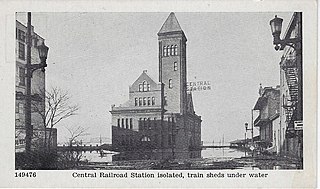
Central Station was a major train station in Louisville, Kentucky. Built in the Richardsonian Romanesque style, it served several railroad companies until the mid-20th century. It was situated at North 7th Street and West River Road, near the Ohio River waterfront, and it was also known as the 7th Street Depot.
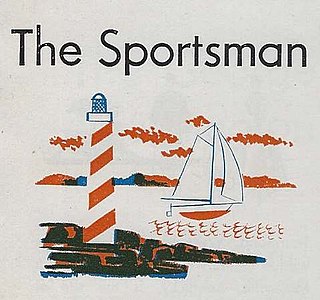
The Sportsman was a named passenger night train of the Chesapeake and Ohio Railway. It was the Chesapeake and Ohio's long-standing train bound for Detroit from Washington, D.C., and Phoebus, Virginia, on the Chesapeake Bay, opposite Norfolk, Virginia. It was unique among C&O trains for its route north from the C&O mainline in southern Ohio. For most of its years it had a secondary western terminus in Louisville at its Central Station.
















